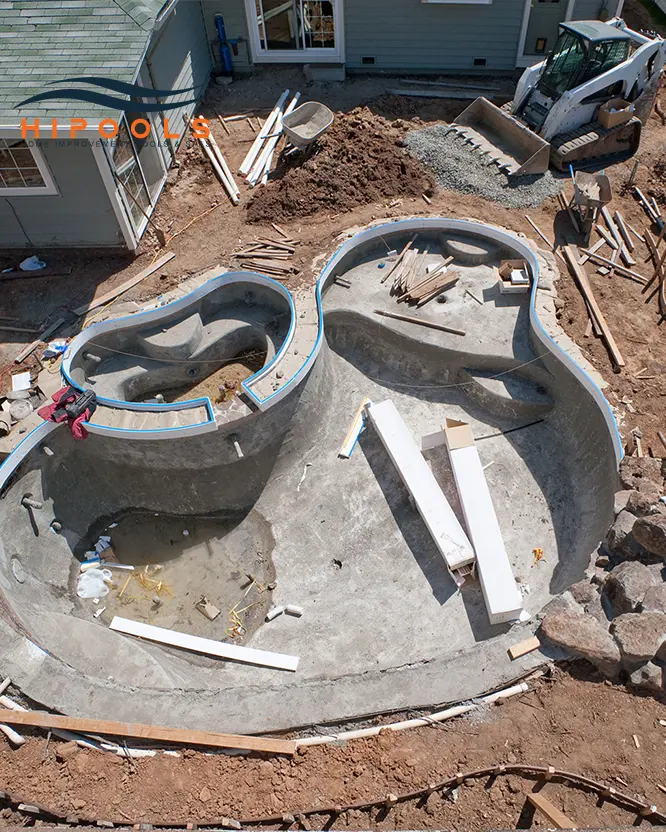Planning to construct or renovate your dream pool? The materials you use for your pool can break or make the style, durability, and maintenance of your swimming oasis. You want contemporary, sleek looks or timeless, classic atmosphere? Deciding the right pool building materials is critical. With so many various options available with each offering a unique set of benefits, it becomes confusing. Fear not! Here in this guide, we will help you through the top pool building materials so you can make a good decision for a long-term and appealing pool.
Consider the Climate and Location
As you select pool building materials, your location and climate need to be considered as one of the first aspects. Your weather will significantly affect the lifespan and performance of your pool materials. For instance, concrete pools are weather-resistant in any environment but might require special attention in freezing climates. Fiberglass pools, on the other hand, have great resistance to extreme weather and are ideal for climates with constant sun and heat. Consider environmental factors like tree canopy and ground, which may affect your choice of pool materials in terms of weather resistance as well as ease of maintenance.
Evaluate Pool Material Durability
Durability is crucial when choosing pool materials for your construction project. Concrete pools are very strong and versatile, with shape and size options. However, they need resurfacing and maintenance. Fiberglass pools are pre-molded and are less demanding in terms of maintenance, but they can be restrictive in design flexibility offered by concrete pools. Vinyl-lined pools are a more affordable option, though the liners will need to be replaced in a few years. Consider both the durability and maintenance requirements of each material to determine whether it meets your long-term pool ownership goals.
Budget and Maintenance Considerations
Your budget plays a big role in determining pool construction materials. Even though concrete pools can be designed to any shape, they are generally more expensive to buy and require more maintenance fees. Vinyl pools, while less expensive to buy to begin with, could potentially involve more liner changes. Fiberglass pools, while generally more expensive than vinyl, are low upkeep and save the owner money long-term due to their hard exterior. Take into account the initial expense and the long-term maintenance expense so that you can select a material that is cost-effective and fits your lifestyle.
Think About Aesthetics and Finish
The visual appeal of your pool can be as important as its functionality. Concrete pools are flexible and offer a range of finishes such as plaster, pebble, or tile, so that you can have a customized finish to match your outdoor appearance. Fiberglass and vinyl pools, while less limited in terms of finishes, are available in a few colors and textures that provide visual interest. Consider how each material will blend with your backyard design and complement the overall pool look, as well as how the finish can affect cleaning and maintenance in the long run.
By keeping these aspects in mind—climate, durability, budget, and aesthetics you can make an informed decision while choosing the most appropriate pool materials for your construction project.

Consider Maintenance and Safety When Choosing Pool Construction Materials
When selecting pool building materials, maintenance and safety must be your primary concerns. After all, a pool is where you want to unwind, not where you want to spend all your time fixing. Selecting materials that are easy to maintain and safe will save you money and time and keep your pool in top shape for years to come. Here are some important things to keep in mind:
1. Choose Easy-to-Clean Materials
Some products inherently need to be cleaned and maintained more than others. When constructing your pool, choose low-maintenance and easy-to-clean materials. Fiberglass pools, for instance, are smooth surfaced and will not allow algae or debris to adhere to them, making them a breeze to clean and resistant to staining. Vinyl-lined pools also provide a smooth surface that is resistant to dirt and easy to clean with a wipe. While concrete pools can be highly customized, they do have to be cleaned and resurfaced more frequently due to their porosity. Choose a material that will fit your preference for pool maintenance time.
2. Get Automatic Pool Covers
Pool covers are a critical element of having a clean and safe pool. A heavy-duty pool cover excludes leaves, branches, and dirt from your pool, which cuts cleaning time. It also maintains water temperature stable and reduces chemicals, saving you money in the long run. Automatic pool covers are also a simple solution, offering easy use with the push of a button. They also provide you with additional security by keeping unwanted guests out of the pool, which is particularly important if you have children or pets. Choose a pool cover that is durable, easy to apply, and suits the design of your pool.
3. Install Pool Lighting for Safety
Good pool lighting is not only important for looks but also for safety. LED pool lighting is an excellent option for reducing maintenance while beautifying your pool. These energy-saving lights offer good visibility for nighttime swims and prevent accidents by illuminating the pool area at all times. Because LED lights last a long time, they need to be replaced less often than other types of lighting, further saving on maintenance expenses.
4. Select Long-Lasting Pool Decking Materials
Your pool decking must not only be compatible in design with the pool but also safe and durable. Choose materials that are slip-resistant yet wear and tear-resistant, especially in the pool perimeter area. Concrete pool decking can be treated with a slip-resistant finish, while tile or stone decking is durable and aesthetically appealing. Low-maintenance and weather-resistant materials can ensure that the pool area remains safe and operational for years to come.
Choosing the right pool materials to consider maintenance and safety can reduce your long-term maintenance and offer a safer swimming pool environment. Pick materials that fit your clean-up mode, invest in safety features like pool covers and sufficient lighting, and ensure your decking is both slip-resistant and durable. Through savvy choices, your pool will be a beautiful and low-maintenance sanctuary for decades.

Energy Efficiency and Sustainability in Pool Construction
In picking pool building materials, being sustainable and energy-efficient is the more important aspect. Opting for sustainable, energy-efficient building materials not only lessens your carbon footprint, but can be cost-effective too in the future. These are some key areas to consider toward a more eco-friendly pool:
1. Opt for Energy-Efficient Pool Equipment
Other than construction materials, the equipment that you select is crucial in ensuring your pool is energy-efficient. High-efficiency pumps, heaters, and filtration equipment can greatly reduce energy use. Select variable speed pumps that automatically adjust to your pool’s needs, thus reducing electricity usage without compromising the pool’s cleanliness and maintenance.
2. Use Solar Pool Heating
For a more environmentally friendly heating solution, look at solar pool heating systems. Solar pool heating systems harness the sun’s energy to warm your pool water, a free and renewable resource. Installing solar panels can minimize your dependence on conventional energy sources and save on heating costs in the long run. Solar covers also keep the heat in, minimizing the need for supplementary heating systems.
3. Choose Sustainable Pool Finishes
There are many sustainable pool finishes like recycled glass tile or natural stone that offer beauty and sustainability. They are most likely sourced from sustainable suppliers and can be added to your more sustainable pool design. Reducing your environmental impact can be done by adding recycled materials as a component in constructing your pool finishes and deck.
4. Add Water-Saving Features
Yet another crucial aspect of sustainable pool design is water conservation. Install water-saving devices such as evaporation preventers, effective pumps, and rainwater catchment systems to replenish your pool. Such devices save water without sacrificing cleanliness and health of the pool.
By focusing on energy-efficient pool materials and sustainable design alternatives, you can create a green pool that not only will benefit the earth but also reduce your long-term energy and water expenses. Incorporating these into your pool construction will make your pool fun and responsible as a home renovation.
How long does a pool built with concrete last?
A concrete pool will endure for 50 years and even longer when properly maintained. Daily cleaning and occasional resurfacing, though, is essential in order to keep it durable for a long time.
Is a fiberglass pool more expensive than a concrete pool?
Fiberglass pools tend to be more expensive to install than vinyl pools but are usually cheaper than concrete pools. Concrete pools have more design freedom, but fiberglass pools require fewer repairs, which saves you money in the long run.
Budget-Friendly Secrets for Choosing the Best Pool Construction Materials
Penny-pinching does not necessarily mean you will have to sacrifice the quality of your pool. The following are some budget-friendly tips for choosing pool materials:
1. Choose Vinyl Pools
Vinyl-lined pools are the most affordable with low initial cost and minimal upkeep. The liner must be replaced every 7-10 years, but they will save you money in the long run.

2. Employ Standard Designs
Choose a standard shape for fiberglass or vinyl pools in order to save on customization costs. Standard designs are quicker to install and cheaper.
3. Choose Simple Pool Finishes
Choose plaster or plain vinyl finishes instead of expensive tiles or highly reflective stone finishes, conserving materials and labor expenses.
4. Invest in Energy Efficiency
Energy-efficient options like solar heating and LED lighting are more expensive upfront but reduce long-term operating expenses, saving you electricity dollars.
5. Use Concrete Decking
Concrete decking is cheap, durable, and can be textured to mimic more expensive materials, cost-saving.
6. Fit a Pool Cover
A pool cover reduces time and energy by preventing debris and evaporation, and is thus a worthwhile investment.
7. Get Local Materials
To avoid the cost of shipping, buy materials locally. This can significantly lower your overall project cost.
By focusing on low-maintenance, energy-efficient, and cost-effective materials, you can build a wonderful pool without draining your finances.
Last thought
At HiPoolss, we would like your pool to be the epitome of sophistication, functionality, and value. Whether you are building a new pool or restoring an existing one, we offer professional guidance and high-quality materials to make your project a success. From sustainable and durable materials to energy-efficient solutions, we present to you the best possible options that appeal to your sense of style and budget. Let us help you make your pool dream come true with quality products and excellent service.
Start your journey to a stunning, low-maintenance pool with HiPoolss today!


No comment